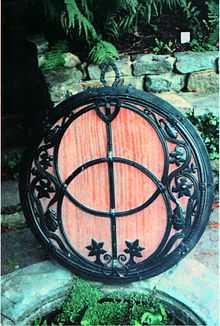Vesica piscis

The vesica piscis is a shape that is the intersection of two circles with the same radius, intersecting in such a way that the center of each circle lies on the perimeter of the other. The accurate geometrical construction is described within the prominent place of the first Proposition, of the first Book of Euclid's Thirteen Books of Elements (c.300 BC). [1]The name literally means the "bladder of a fish" in Latin. The shape is also called mandorla ("almond" in Italian).
The term is also used more generally for any symmetric lens.[2]
Mathematical description

The mathematical ratio of the height of the vesica piscis to the width across its center is the square root of 3, or 1.7320508... (since if straight lines are drawn connecting the centers of the two circles with each other and with the two points where the circles intersect, two equilateral triangles join along an edge). The ratios 265:153 = 1.7320261... and 1351:780 = 1.7320513... are two of a series of approximations to this value, each with the property that no better approximation can be obtained with smaller whole numbers. Archimedes of Syracuse, in his On the Measurement of the Circle, uses these ratios as upper and lower bounds:[3]

Mysticism
The vesica piscis has been the subject of mystical speculation at several periods of history, and is viewed as important in some forms of Kabbalah. More recently, numerous New Age authors have interpreted it as a yonic symbol and claimed that this, a reference to the female genitals, is a traditional interpretation.[4][5][6][7][8][9]
One author claims that the total solar eclipse inspires images of the vesica piscis.[10] The ancient Egyptians practiced sacred geometry based on the shape. Architects and artists copied the solar eclipse/vesica piscis and its mathematics in their sacred buildings and artwork to reflect their religious beliefs. This ancient tradition was passed on through the centuries by the Freemasons.[11]
Uses
In Christian art, some aureolas are in the shape of a vertically oriented vesica piscis, and the seals of ecclesiastical organizations can be enclosed within a vertically oriented vesica piscis (instead of the more usual circular enclosure). Also, the icthys symbol incorporates the vesica piscis shape.
The cover of the Chalice Well in Glastonbury (Somerset, United Kingdom) depicts a stylized version of the vesica piscis design (see picture).
The vesica piscis has been used as a symbol within Freemasonry, most notably in the shapes of the collars worn by officiants of the Masonic rituals.[12] It was also considered the proper shape for the enclosure of the seals of Masonic lodges.[13][14]
The vesica piscis is also used as proportioning system in architecture, in particular Gothic architecture. The system was illustrated in Cesare Cesariano's Vitruvius (1521), which he called "the rule of the German architects".
The shape may be found in the topology of certain networks.
Gallery
-

Christ in Majesty within a mandorla-shaped aureola in a medieval illuminated manuscript
-
Christ in majesty within a mandorla-shaped aureola, surrounded by emblems of the evangelists (13th century)
-

Christ within a mandorla-shaped aureola, surrounded by emblems of the evangelists (fresco)
-
Church of Scotland logo
-

Coat of arms of Guam
-

Madonna in mandorla attended by angels.
-

Official seal of Johns Hopkins University
-

Christ at Chartres
References
- ↑ Heath, Sir Thomas L. (1956). The Thirteen Books of Euclid's Elements (2 ed.). New York: Dover Publications Inc. p. 241. ISBN 0486600904.
- ↑ Weisstein, Eric W., "Lens", MathWorld.
- ↑ Heath, Thomas Little (1897), The Works of Archimedes, Cambridge University, pp. lxxvii ; 50, retrieved 2010-01-30
- ↑ Barbara Walker, The Woman's Encyclopedia of Myths and Secrets (Harper San Francisco, 1983).
- ↑ Kevin L. Gest, The Secrets of Solomon's Temple (ISBN 0853182566).
- ↑ Kathy Jones, The Goddess in Glastonbury (1990).
- ↑ Margaret Starbird, Magdalene's Lost Legacy, Symbolic Numbers & Sacred Union.
- ↑ Constance S. Rodriguez PhD, LCSW - Sacred Portals, Pathways to the Self (ISBN 9781403375926).
- ↑ Dion Fortune, The Mystical Qabalah (1935).
- ↑ Nicholas R. Mann, The Sacred Geometry of Washington, D.C. p. 92 (Barnes & Noble, 2006)
- ↑ Nicholas R. Mann, The Sacred Geometry of Washington, D.C., p. 92 (Barnes & Noble, 2006)
- ↑ J. S. M. Ward, An Interpretation of Our Masonic Symbols, 1924, pp. 34–35.
- ↑ Albert G. Mackey, Encyclopaedia of Freemasonry, 1921 ed., vol. 2, p. 827.
- ↑ Shawn Eyer, The Vesica Piscis and Freemasonry. Retrieved on 2009-04-18.
| Wikimedia Commons has media related to Vesica piscis. |
See also
- Halo (religious iconography)
- Ichthys
- Flower of Life
- Villarceau circles
- Triquetra
- Reuleaux polygon
- Catch of 153 fish
- Venn diagram
- Intersection (set theory)
- Swim bladder

